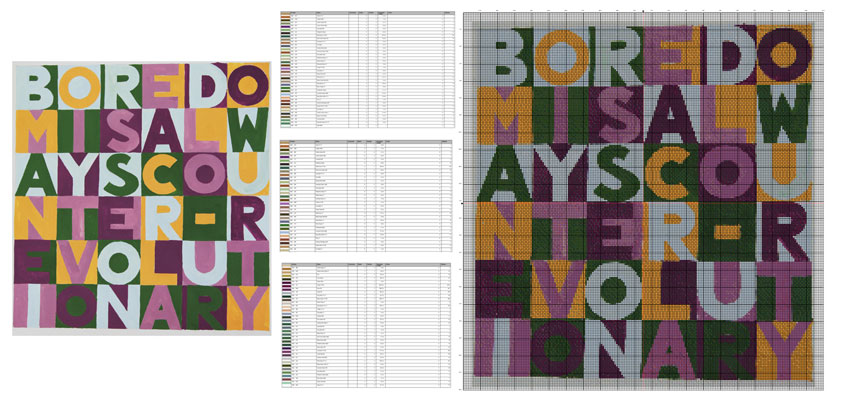RICHARD
GRAYSON
Boredom is Always Counter Revolutionary
Cross stitch tapestry, gouache and computer generated patterns 2013-16
Cross stitch tapestry, 50 x 60 cm |
A needlework tapestry made between 2012 and 2015 consists of approximately 22,000 cross-stitches, spelling out 'Boredom is Always Counter-Revolutionary'. The phrase, Boredom is Always Counter-Revolutionary, comes from a text by Guy Debord published in the Situationist International Journal in 1962. This later became a popular graffiti during the May 1968 events in Paris. This phrase is the starting point for a series of tapestry designs in gouache, which develop numerous variations on the original design.
Boredom is Always Counter-Revolutionary looks at ways that ideas of work, labour and craft have been imagined from the 19th century to the present day, and how people now use manual activities and the techniques of craft to make objects that have a value and worth outside simple ideas of production. A starting point for the cross-stitch works are the samplers that were made by children and adults in pre-industrial and industrial Europe. The Victoria and Albert Museum has examples from the 14th century onwards. Their function changed over time, from a training tool and pattern resource for artisans, to decorative pictures, to formulaic schoolroom exercises, shifting from being a professional resource and means of productions to an amateur and domestic or hobbyist pastime.
As industrialisation and technology became dominant, these craft skills took on another loading and value, invested with qualities that machine and factory production did not allow: such as care, reward and personal pleasure.
The central question for Guy Debord was how might people find meaning and significance in the modern world, a world that alienated people not only from their work but from our experience of life. He considered play and spontaneity as the cornerstones necessary for a fulfilling life. Boredom to them was a modern phenomenon, a modern form of control. People felt their condition not exactly as a fact but simply as a fatalism, devoid of meaning, which separated every man and woman from each other.
By Our Own Hand (2017) builds on this work as the basis of a collaborative project. Community embroiderers hobbyists and stitchers are invited to make their own work featuring an individual letter of the text. The individual panels will be assembled to form the full text on a banner scale.
| To participate in By Our Own Hand contact: Katrina Black at Matt's Gallery, London |
For further information and details of participation download pdf : |  |

gouache and computer generated patterns